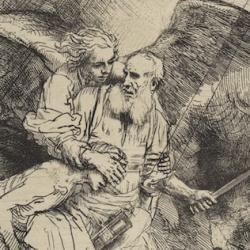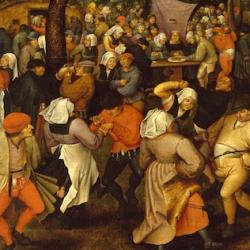John 8:1-11 is a difficult, controversial passage in all sorts of ways. There are strong text-critical arguments for claiming it’s not part of the original text of John. It would be a convenient absence, because if it’s genuine, the passage raises all sorts of puzzles. The Pharisees who bring the woman seem to be demanding that Torah be carried out; is Jesus’ opposition to their charge imply His opposition to Torah itself? Why, further, does he write on the ground—of the temple? And what about the famous statement, “He who is without sin among you, let him cast the first stone”? If that’s taken as a universal principle, it seems to undermine the possibility of coercive authority of any kind: Because there are no sinless judges other than Jesus and He refuses to judge. Are we looking at Jesus the anarchist? On the other hand, taking the comment as a riposte seems cheap: It seems too portentous a statement to be merely rhetorical.
René Girard’s analysis of the passage offers some help. Jesus is faced with a mob action, a crowd of Pharisees and scribes at least, perhaps joined by others who have been listening to Jesus teach, stirred up to a violent frenzy. By forcing the accusers to self-examination, he individualizes and personalizes the mob. If each is considering his own sin, he cannot so easily be caught up in the contagion of the crowd.
Two further observations might help. First, what are we to make of Jesus’s writing on the ground? The most direct analogy from the Old Testament is the rite of jealousy in Numbers 5. There, a man who suspects his wife of adultery brings her to the temple; the priest concocts a drink containing water and dust from the tabernacle floor. The priest writes out a curse and washes it into the water, and then gives the woman the water to drink. If nothing happens, she is innocent; if her belly swells and her thigh wastes away, she is considered guilty.
Jesus is faced with a similar situation: He is in the temple, there is an accusation of adultery, and he reacts by combining two actions from the jealousy rite. The priest took dust from the tabernacle floor, while Jesus writes on the floor of the temple; the priest writes a curse, and Jesus writes. Jesus takes the position of priest carrying out the jealousy rite.
Second, the law that specifies capital punishment for adultery in Deuteronomy 22:22 states that the purpose is to “purge the evil from Israel.” That’s what the woman’s accusers claim to be doing by bringing her for stoning. Jesus again turns the tables, showing that the hypocritical accusers are themselves the “evil” in Israel. And He purges them, scattering them, and then releasing the woman with the exhortation to “sin no more.”
In short, there are indications that Jesus is fulfilling the law here, in much the same way that He teaches His disciples to fulfill the lex talionis by taking the second slap instead of retaliating, to fulfill the command against murder by seeking reconciliation and by agreeing with adversaries, to fulfill the command against adultery by refusing to gaze upon a woman to arouse lust (Matthew 5). In John as in Matthew, Jesus accomplishes what the law aims at, but does so in surprising ways. He fulfills the law in a way that, to Pharisees like ourselves, appears to law-breaking.
(These reflections are heavily dependent on a discussion of the passage at a recent symposium on René Girard and the Bible. Insights from Gil Baillie, Jerry Bowyer, and Greg Thornbury were especially helpful.)











